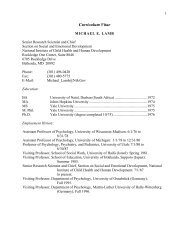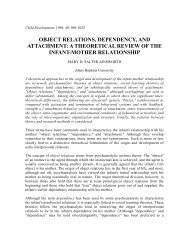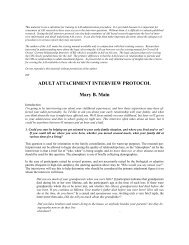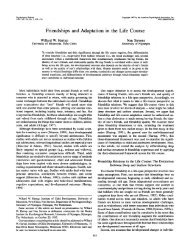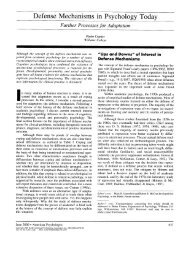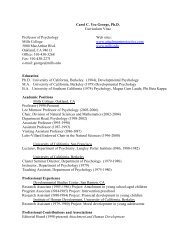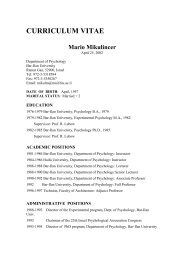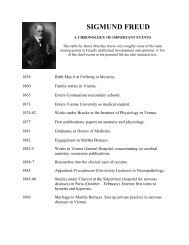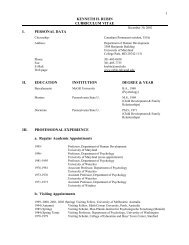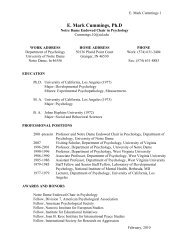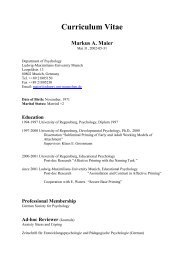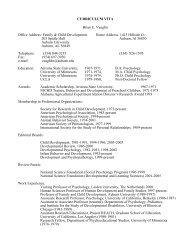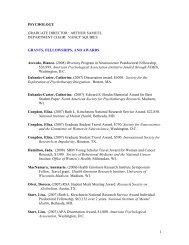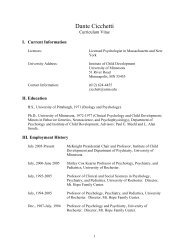the origins of attachment theory: john bowlby and mary ainsworth ...
the origins of attachment theory: john bowlby and mary ainsworth ...
the origins of attachment theory: john bowlby and mary ainsworth ...
Create successful ePaper yourself
Turn your PDF publications into a flip-book with our unique Google optimized e-Paper software.
statistical expertise <strong>the</strong>n unusual for a psychiatrist <strong>and</strong> psychoanalyst. This training is obvious in<br />
<strong>the</strong> revision <strong>of</strong> his paper, “Forty-Four Juvenile Thieves: Their Characters <strong>and</strong> Home Lives”<br />
(Bowlby, 1944), which includes statistical tests as well as detailed case histories.<br />
At <strong>the</strong> end <strong>of</strong> World War II, Bowlby was invited to become head <strong>of</strong> <strong>the</strong> Children’s<br />
Department at <strong>the</strong> Tavistock Clinic. In line with his earlier ideas on <strong>the</strong> importance <strong>of</strong> family<br />
relationships in child <strong>the</strong>rapy, he promptly renamed it <strong>the</strong> Department for Children <strong>and</strong> Parents.<br />
Indeed, in what is credited as <strong>the</strong> first published paper in family <strong>the</strong>rapy, Bowlby (1949) describes<br />
how he was <strong>of</strong>ten able to achieve clinical breakthroughs by interviewing parents about <strong>the</strong>ir<br />
childhood experiences in <strong>the</strong> presence <strong>of</strong> <strong>the</strong>ir troubled children.<br />
To Bowlby’s chagrin, however, much <strong>of</strong> <strong>the</strong> clinical work in <strong>the</strong> department was done by<br />
people with a Kleinian orientation, who, he says, regarded his emphasis on actual family<br />
interaction patterns as not particularly relevant. He <strong>the</strong>refore decided to found his own research<br />
unit whose efforts were focused on mo<strong>the</strong>r-child separation. Because separation is a clear-cut <strong>and</strong><br />
undeniable event, its effects on <strong>the</strong> child <strong>and</strong> <strong>the</strong> parent- child relationship were easier to<br />
document than more subtle influences <strong>of</strong> parental <strong>and</strong> familial interaction.<br />
Mary Ainsworth<br />
Mary Ainsworth (nee Salter), 6 years younger than Bowlby, finished graduate study at <strong>the</strong><br />
University <strong>of</strong> Toronto just before World War II. courses with William Blatz had introduced her<br />
to security <strong>the</strong>ory (Blatz, 1940), which both reformulated <strong>and</strong> challenged Freudian ideas, though<br />
Blatz chose not to recognize his debt to Freud because <strong>of</strong> <strong>the</strong> anti-Freudian climate that pervaded<br />
<strong>the</strong> University <strong>of</strong> Toronto at that time (Ainsworth, 1983; Blatz, 1966).<br />
One <strong>of</strong> <strong>the</strong> major tenets <strong>of</strong> security <strong>the</strong>ory is that infants <strong>and</strong> young children need to develop<br />
a secure dependence on parents before launching out into unfamiliar situations. In her disserta-<br />
tion, entitled “An Evaluation <strong>of</strong> Adjustment Based Upon <strong>the</strong> Concept <strong>of</strong> Security,” Mary Salter<br />
(1940) states it this way:<br />
Familial security in <strong>the</strong> early stages is <strong>of</strong> a dependent type <strong>and</strong> forms a basis from which<br />
<strong>the</strong> individual can work out gradually, forming new skills <strong>and</strong> interests in o<strong>the</strong>r fields.<br />
Where familial security is lacking, <strong>the</strong> individual is h<strong>and</strong>icapped by <strong>the</strong> lack o~ what<br />
might be called a secure base italics added from which to work. (p. 45)



